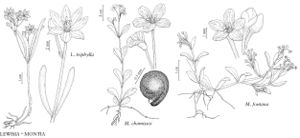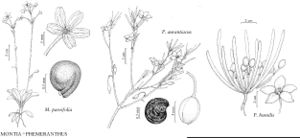Montia
Sp. Pl. 1: 87. 1753.
Gen. Pl. ed. 5, 38. 1754.
Herbs, annual, biennial, or perennial, sometimes rhizomatous and/or stoloniferous, or with branched caudices (M. parvifolia), sometimes bulbiferous, succulent, glabrous. Stems prostrate to decumbent or erect, usually branched, often rooting at nodes. Leaves cauline and sometimes basal; basal leaves in rosettes; cauline leaves 3 or more, alternate, opposite, or secund, distinct, not articulate at base, somewhat to markedly clasping, attachment points linear, petiolate or sessile; blade linear, oblong, lanceolate or oblanceolate to rhombic, ovate, or suborbiculate. Inflorescences axillary or terminal, racemose, somewhat to markedly secund (at least terminally), ebracteate or 1-bracteate at base of each flower. Flowers radially symmetric (slightly irregular in M. fontana), not showy (except in M. parvifolia and M. bostockii), occasionally replaced by bulbils in M. chamissoi; sepals persistent, unequal; petals 5, sometimes absent, usually distinct (connate proximally in M. fontana); stamens 3–5 (occasionally 2 in M. howellii); ovary globose or linear-oblong, ovules 3; style 1; stigmas 3. Capsules 3-valved, longitudinally dehiscent from apex, valves not deciduous, margins involute. Seeds 1–3, black, rounded, tuberculate (appearing smooth in M. parvifolia); elaiosome absent or, less than 1 mm. x = 7, 8, 10, 11.
Distribution
Worldwide
Discussion
Species 12 (8 in the flora).
The classification of Montia is in transition. It is widely recognized that the genus as traditionally treated is a rather disparate assemblage of species, albeit closely related. Several segregate genera have been described, but as R. C. Carolin (1993) has observed, “while some are almost certainly recognizable at the generic level, the others probably less certainly.” With the current legitimate uncertainty, it is appropriate to treat Montia here in the broad, traditional sense. To do otherwise is to give the impression that we know more about the relationships of the species than is actually the case.
Selected References
Lower Taxa
Key
| 1 | Leaves opposite, never alternate or borne on flowering stems | > 2 |
| 1 | Leaves alternate or secund, or borne on flowering stems | > 3 |
| 2 | Plants annual or biennial, never bulbiferous; stems prostrate or decumbent; stamens 3 | Montia fontana |
| 2 | Plants perennial, usually bulbiferous; stems erect; stamens 5 | Montia chamissoi |
| 3 | Petals 6-15 mm, always present; plants rhizomatous or stoloniferous, often bulbiferous | > 4 |
| 3 | Petals 0.7-6 mm, sometimes absent; plants not rhizomatous, stoloniferous, or bulbiferous | > 5 |
| 4 | Plants not bulbiferous; leaves not in basal rosette; inflorescences 1-bracteate; Alaska, Yukon | Montia bostockii |
| 4 | Plants often bulbiferous; leaves in basal rosettes; inflorescences leafy; Pacific coast, cordillera of w North America | Montia parvifolia |
| 5 | Leaf blades 10-40 mm wide; clasping leaf sheaths absent; stamens 5 | Montia diffusa |
| 5 | Leaf blades 0.5-4 mm wide; clasping leaf sheaths present; stamens (2-)3-5 | > 6 |
| 6 | Petals often absent; inflorescences axillary | Montia howellii |
| 6 | Petals present; inflorescences terminal | > 7 |
| 7 | Flowers 2-8; seeds 1.2-2.6 mm; stems 2-30 cm | Montia linearis |
| 7 | Flowers 4-12; seeds 0.8-1.2 mm; stems 1-10 cm | Montia dichotoma |

